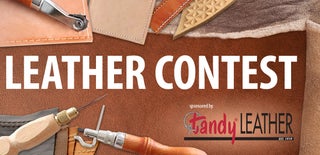Introduction: Leather Fore Arm Bracers
Recently I have become very interested in leather crafting. I have only done a few projects so far and do not yet have many leather related tools, but have found that with a few simple tools you can get a lot done.
Needed tools:
Hole punch, heavy duty scissors or razor blade, leather swivel blade, blending tool, mallet, solid block or sturdy surface, pliers, rivets, buckles, leather, Dye or Glaze, Rags, craft paper, ball point pen, tracing paper or acetate.
Step 1: Step 1: Measure Twice Cut Once.
There are only three measurements needed for the standard wrist bracer project. Start by measuring the distance around your wrist ( this will be the width of the bottom), Then measure the circumference of your fore arm ( this will be the width of the top), Finally measure the distance from your wrist to fore arm (this is the height). After you have your measurement cut a piece paper or poster board to your measurements, removing a half inch from both sides of the bracer to allow for lacing or buckles. Test the fit by folding the paper around your arm. You may need to use rubber bands to hold it in place. The bottom and top of the bracers will need to have a slight radius so that they fit properly. No two fore arms are the same so be sure to check that your pattern works for both of your arms. If not, simply pattern one for your other arm and be sure to label them so that you don't get confused. Whenever working on Leather projects I always use paper to make my patterns and adjustments.This will keep you from wasting materials.
Once you have your pattern fitting perfectly your ready to cut the leather. This can be done using heavy duty scissors or a razor blade and cutting board. Be careful and take your time.
Now that your leather is cut, its a perfect time to lay out your logo or pattern. I simply printed the logo I wanted out and then traced the logo onto a piece of acetate. I used an old ball point pen to trace the pattern into the leather under the acetate ( Always wet your leather before you try to do any tooling)
Step 2: Step 2: Tooling the Leather
Photo 1. You can see how well the leather takes to the ball point pen. They make a tracing tool for leather but I dont have one yet.
Photo 2. I used a swivel blade to define the outline. Be careful not to bring your logo or detail too close to the edge of the leather. While making these bracers I noticed that the North and South points on the compass rose actually weaken the edges of the bracers.
Photo 3 shows the final tooling. I simply used a fade tool to give depth to the image.
Step 3: Step 3: Hardware or Lace
I decided to use buckles and straps, you can use laces or wraps but I previously made a pair of bracers that utilized laces and found that laces take forever to adjust and are difficult to tie by yourself. After trying both styles I will always choose to go with buckles.
If you decide to go with buckles I recomend choosing a style that you can both find in the correct amount and that are not very expensive. I used 6 buckles that cost me about 1.89 each.
I cut scrap pieces of leather into straps about an inch wide. I wanted the straps to be secure so I decided on using 2 rivets per strap, I then had to narrow the lengths of straps to 3/4 of an inch to fit through the buckles, while still leaving enough leather to rivet to the bracers.
Punch holes and temporarily set the rivets with a pair of pliers.
Try the bracers on and adjust as necessary, I had to fiddle with the straps a bit so that they aligned with the corresponding buckles. Once everything fits the way you want be sure to permanently secure your rivets with a mallet and block.
Step 4: Step 4: Dye and Finish
I used an antique glaze for the bracers themselves and a darker shoe dye for the straps. Once the Glaze and dye is applied and buffed Its time to treat the edges. There are several ways to do this and most people would opt to clean up the edges and dye the leather before assembling all the pieces. But, because there was so much adjustment needed during assembly I decided to leave the messiest step till the end. I used a short piece of a wooden dowel to burnish the edges of the finished pieces. To burnish I just take the wooden dowel and slide it along the edge of the leather to round off the edge.
I hope you have enjoyed this short instrucable, Thanks for taking a look.
Billy

Participated in the
Leather Contest

Participated in the
Halloween Costume Contest 2015











